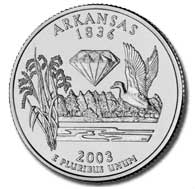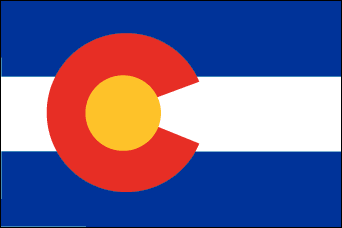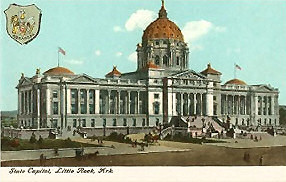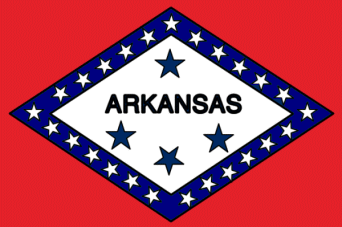THE QUARTER:
 |
| U.S. Mint image |
The Arkansas quarter is the fifth and final quarter of 2003, and the 25th in the 50 State Quarters® Program. Arkansas was admitted into the Union on June 15, 1836. Arkansas was acquired through the Louisiana Purchase and later became the Arkansas Territory before gaining statehood. The Arkansas quarter design bears the image of rice stalks, a diamond and a mallard gracefully flying above a lake. It is fitting that the "Natural State," Arkansas's official nickname, chose images of natural resources. Arkansas has an abundance of clear streams, rivers and lakes. In fact, Arkansas has more than 600,000 acres of natural lakes. Arkansas is also known for its sportsmanship and boasts mallard hunting as a main attraction for hunters across the nation. Visitors to Arkansas can search Crater of Diamonds State Park for precious gems including, of course, diamonds. The mine at Crater of Diamonds State Park reportedly is the oldest diamond mine in North America, and the only one in the United States open to the public-visitors get to keep what they find. Visitors can also experience "Rice Fever" in Arkansas-just the way W.H. Fuller did when he grew the first commercially successful rice crop in Arkansas. Soon after, thousands of acres of the Grand Prairie were changed to cultivate rice, and Arkansas became the leading producer of the grain in the United States. In January 2001, Governor Mike Huckabee announced the Arkansas Quarter Challenge as a statewide competition. A two-week media tour promoting the Challenge resulted in 9,320 entries. After several rounds of elimination, the Governor forwarded three concepts to the United States Mint, including Arkansas' natural resources and the State Capitol building. The United States Mint provided four candidate designs based on the concepts to the Governor from which he chose the natural resources design.
The Arkansas State Flag
The battleship U.S.S. Arkansas was to be commissioned and the Pine Bluff chapter of the Daughters of the American Revolution voted to present an Arkansas State Flag to the ship. The committee dutifully sent a letter off to Secretary of State Earl W. Hodges to learn more about the flag. They received a reply to their letter explaining that Arkansas had no state flag. The Pine Bluff Daughters decided that this situation had to be corrected and sponsored a statewide flag design contest. Secretary of State, Hodges chaired the committee to select the flag design and chose a distinguished group to assist him: Dr. Junius Jordan, the Chairman of Philosphy and Pedagogy at the University of Arkansas; Mrs. Julia McAlmont Noel, a member of the John McAlmont chapter of the D.A.R. in Pine Bluff; Miss Julia Warner, a teacher in the Little Rock school system, and Mrs. P.H. Ellsworth, a former president of the Arkansas Federation of Women's Clubs. Sixty-five entries were received in different formats, from crayon drawings to miniature silk flags. Many of the entries featured the state flower, the Apple Blossom, in different settings. The entry chosen was a red, white and blue design by Miss Willie Hocker of Wabbaseka, a member of the Pine Bluff chapter of the D.A.R., where the idea for the contest originated. The design depicted a large white diamond bordered by twenty-five stars on a blue band. A straight line of three blue stars was centered in the diamond. The flag committee thought the state's name should be on the flag, Miss Hocker agreed and suggested that the blue stars be re-arranged with one star above the name and two below. The Arkansas Legislature adopted Miss Hocker's design as the official state flag of Arkansas. The U.S.S. Arkansas recieved this flag from the Pine Bluff chapter of the D.A.R.... Wait!... There's more. Trouble was brewing. The design committee had neglected to consider the role of Arkansas as a member of the Confederate States of America from 1861 to 1865. To correct this, in 1923 the Legislature voted to add another star above the state name. This fourth star was placed above the letter "R" in Arkansas and the original star above the name was moved to a position above the last "A" in Arkansas. This time an uproar came from those who claimed the addition of the fourth star compromised the original meaning and symmetry of the design. So, in 1924, the Arkansas Legislature addressed the design of the state flag again. The original three stars were moved below the state name and the additional star was centered above the state name. This is the way the flag is today.
The flag displays a white diamond on a red field. The white diamond is bordered by a band of blue containing twenty-five stars. The state name is centered in the diamond. Three stars are placed below the state name and one is centered above the state name. The colors of the flag, red, white and blue associate the state with the United States of America. The three blue stars below the state name represent the three countries that the territory belonged to (France, Spain and the United States), the year (1803) that Arkansas was aquired by the United States as part of the Louisiana Purchase and that Arkansas was the third state created from the purchase. The two stars below and parallel to the state name represent the twin states, Arkansas and Michigan, both admitted to the union at about the same time: Arkansas on June 15, 1836 and Michigan on January 26, 1937. The single star above the state name represents Arkansas' membership in the Confederate States of America. Twenty-five stars in the blue band represent Arkansas as the twenty-fifth state admitted to the union. The diamond signifies Arkansas as the only diamond-producing state in the nation. State Statute If you want more information on the State Flags of the United States, you might want to check How Proudly They Wave: Flags of the Fifty States by Rita D. Haban. This book is geared toward kids... and for adults like me who want to know about the history and design significance of the flags of all fifty states but can't find this information in an expensive encyclopedia. |







